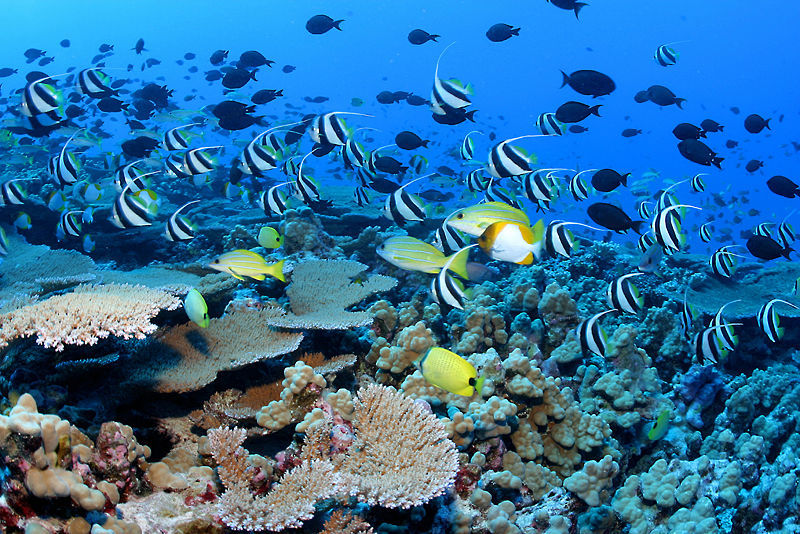On December 5 the PBS NewsHour showed a segment titled “Endangered Coral Reefs Die as Ocean Temperatures Rise and Water Turns Acidic,” with Hari Sreenivasan reporting. The story discussed the recent loss of Florida coral reefs and the possible impact on recreation and tourism if reef degradation continues. But PBS wrongly told viewers reef degradation was due to warmer ocean temperatures and “ocean acidification,” both allegedly caused by human carbon dioxide emissions. Sreenivasan concluded with a reference to, “time that maybe is running out for coral reefs in Florida and elsewhere.”
Hugely Exaggerated Claims
Scientists, environmental groups, and the United Nations often promote fear of ocean acidification. According to claims, manmade emissions of carbon dioxide are absorbed by the oceans and converted into carbonic acid, thereby changing the chemical balance of the oceans. The basic concept is correct, but hugely exaggerated.
The PBS segment is wrong in several ways. First, although today’s temperatures are the warmest in the last 400 years, oceans were warmer still during the Medieval Warm Period ten centuries ago. Peer-reviewed studies found both the Gulf of Mexico and nearby Sargasso Sea were warmer around 1000 AD than at present. These warm temperatures were due to natural climatic changes of Earth, not manmade emissions. Caribbean reefs adapted to these warm seas to remain with us today.
Second, the segment paints a misleading picture of carbon dioxide entering the oceans, without providing perspective for the viewer. Sreenivasan interviews scientist Chris Landon, who states, “And it’s enough railroad cars stacked end to end to wrap around the earth seven times. That’s how much carbon is going into the ocean every single year.” This sounds alarming, unless you know that the oceans absorb and release about 90 times that amount of CO2 every year from the atmosphere naturally. In addition, carbon dioxide is absorbed by vast deposits of limestone rock in the ocean floor, removing it from sea water.
Third, the oceans are alkaline, not acidic. We’re discussing a reduction in alkalinity. Solutions are measured as acidic or alkaline (basic) on a logarithmic 14-point scale, called the pH scale. Battery acid has a pH of about one, whereas the base lye has a pH as high as thirteen. Milk is slightly acidic, as are most of the foods we eat.
Measured in the open ocean, sea water is alkaline, with a pH of about 8.2. According to computer models, doubling of atmospheric CO2 would decrease ocean pH to about 7.9, still basic, though less so. The concern is that this change would destroy the coral reefs by dissolving the carbonate shells and skeletons of reef creatures. Sreenivasan states, “Acidification acts a lot like osteoporosis does in humans. But in marine animals, it makes their shells and skeletons brittle. The more acidic the water, the harder it is for corals to grow their skeletons.”
Calcification Not Impaired
But empirical evidence does not show it is harder for today’s marine animals to grow their shells. A study of corals at the Great Barrier Reef shows shell calcium growth rates today are about 25 percent higher than 300‒400 years ago when both ocean temperatures and levels of atmospheric carbon dioxide were lower.
Large Uncertainties Remain
Scientists still know little about the alkalinity of today’s ocean or the oceans of past centuries. Ocean pH varies by depth, with the water becoming less basic as one goes deeper. It varies by latitude from the equator to the poles. It varies by location, such as the open ocean, a coral reef, or kelp bed.
But the PBS segment ignores this uncertainty and suggests the rate of change in ocean pH is alarming. Dr. Langdon states, “What’s really and completely unique about what’s going on now is the rate of change. And that’s what is so difficult for organisms.”
However, evidence shows a high rate of change in ocean alkalinity is natural. A 2011 study by the Scripps Institution of Oceanography found large variations in ocean pH by day, week, and month. Changes in some locations were as high as 0.35 units over the course of a day, higher than computer models are predicting for the next century.
Scuba divers know reef creatures already experience acidic conditions near CO2 vents in the ocean floor. These vents bubble CO2 gas amid coral reefs and grassy ocean pastures in millions of locations. Fish and reefs appear to be doing quite well near these CO2 vents.
The coral reefs in the Caribbean and other seas may be endangered due to overfishing, chemical pollution, and human abuse. But let’s not blame reef degradation on misguided fears about global warming.
Steve Goreham ([email protected]) is executive director of the Climate Science Coalition of America and author of the new book, The Mad, Mad, Mad World of Climatism: Mankind and Climate Change Mania. This article first appeared in the Washington Times and is reprinted with the author’s permission.





